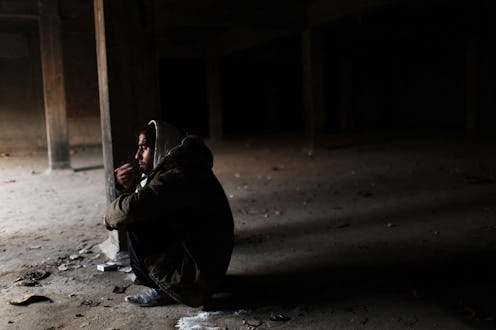News
Flesh-Eating Drug Has Hit Our Streets
On Thursday afternoon, a medical director in Arizona reported that "krokodil," the poisonous street drug that shot to notoriety in Russia for literally rotting the flesh of its users, has made its first appearance in the United States. An official at an Arizona drug-information center claimed that the state had witnessed two cases in the past week.
Yes, that's a tiny percentage of the street drug-using population, but it was only a few years ago that Russian addicts began transitioning to the less expensive, usually fatal "krokodil" — and from there, its popularity exploded.
The drug is typically "cooked" by the addict, cheaply but time-consumingly, from over-the-counter codeine medications mixed with household products. Because codeine drugs are far cheaper than heroin, millions of Russian addicts who had spiraled into poverty through heroin use turned to krokodil as an alternative.
Krokodil is reportedly near-impossible to quit: withdrawals are so potent that ex-users can be in chronic, unbearable pain for up to a month, and are sometimes put in medical comas. It's nearly ten times more potent than morphine, and is, in short, a poison: over time, users' flesh literally rots and peels away from their bones, and before that, their skin develops a scaly, "crocodile"-esque appearance. Users typically die after less than three years of use, but not before the drug has caused serious and permanent brain damage.
Back in the United States, the CIA believes there are already between 600,000 and 800,000 "hardcore" heroin users — but that's a conservative estimate, and doesn't account for regular but so-called "casual" users. That's not as many users as there are in Russia, which has the world's largest population of addicts at roughly two million. Krokodil is almost exclusively a drug for poverty-stricken addicts, who turn to it because they can no longer afford heroin, so it's unlikely that it would ever gain traction amongst those who perceive their drug use as "casual."
But here's the problem: krokodil is easy to make, and hard to outlaw — you'd have to impose serious limits on the prescription of codeine, as Russia has reportedly considered doing — and prohibitively expensive to rehabilitate. If it does take hold of the United States, the epidemic could cost the government billions, not to mention the resulting social effects.
The addiction starts like this: a user spirals into frequent heroin use, and finds that he or she can no longer afford it. Heroin is an expensive drug, with a "high" that lasts only about six hours, meaning the user then has to find a way to afford their next hit. Krokodil is a different kind of "high," but it does mute any heroin withdrawals, though users report that it feels "dirtier." The average krokodil high is an hour and a half, but it takes between 30 minutes and an hour to cook. So the user ends up cooking krokodil, taking a hit, cooking it again, taking another hit — and the spiral continues, now far, far, harder to escape from than heroin.
The Arizona official didn't specify details of the "cases," but he did note that it was the first he'd known of. "As far as I know, these are the first cases in the United States that are reported," he said. "So we're extremely frightened."
Well, don't freak out just yet. Several European countries have reported cases involving Russian expats, but they haven't seen outbreaks akin to that in Russia. It's premature to suggest that the Western world could face anything similar to what Russian authorities are witnessing there, and the claims of the Arizona official haven't even been confirmed yet.
Additionally, since Russia has taught us exactly how devastating the drug can be, developed countries will do all they can to stop its growth. But ignore all media references to krokodil being a "zombie" drug, because it minimizes its potential threat: zombies are, to the best of our knowledge, not a thing, whereas krokodil most certainly is. Just ask Russia.
This video details the effects the drug has on its users. Just a warning, it's pretty graphic.
